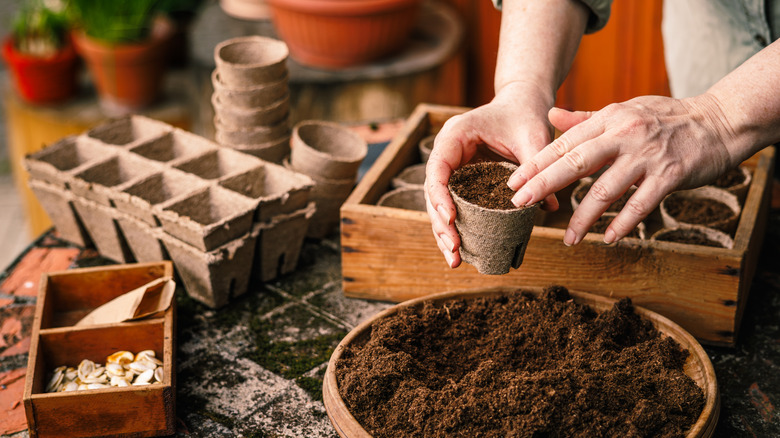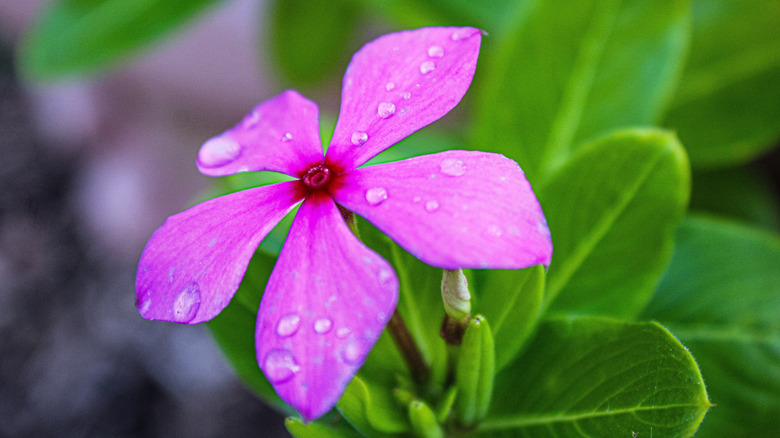The Colorful, Low-Maintenance Flower That Beginner Gardeners Should Grow In Pots
One of the hardest truths about being a beginner gardener is that there can be a lot of trial and error involved in honing your green thumb—a process that can be intimidating if you have your heart set on bright blooms, fragrant flowers, and a thriving garden. While every plant is susceptible to falling victim to some of the most common garden mistakes, there are some types that are more forgiving, making them a perfect plant for beginner gardeners.
Annual vincas (Catharanthus roseus), also known as periwinkle, are eye-catching annuals that are low-maintenance and easy to grow. With no deadheading needed and a tolerance not only for drought conditions but also common garden pests such as deer and rabbits, these flowers can be a great choice for those looking for a hassle-free decorative plant. Plus, with their smaller size, annual vincas can thrive in container gardens — an important feature to keep in mind.
Despite having an overall easygoing care routine, there are still a few steps needed to help annual vincas thrive in your yard. This includes learning more about the different cultivars available and choosing the right option for you.
How to grow annual vincas
There are several different cultivars for annual vincas, ranging in size, color, and even hardiness. Many of the differences revolve around appearance, and while some cultivars are designed to be more resistant to certain conditions, they all showcase the general resilience of the annual vinca. If you are looking to add this plant to a container garden or pot rather than direct sowing in your yard, make sure to choose a smaller variety that can handle being contained.
Once you've chosen the perfect type of annual vinca for your garden, you can get into the specifics of care. Overall, annual vincas aren't picky when it comes to their needs. They can grow well in a range of soil textures, from clay to sand, so long as their soil is well-draining and leans toward an acidic pH. Choosing the right soil for your annual vincas is an essential part of reducing many of the diseases they're susceptible to, such as root rot. As far as sunlight goes, you can grow annual vincas in light conditions as low as dappled sunlight all the way to partial shade or full sun.
What to know before planting annual vincas
Although annual vincas can be an eye-catching annual to add to your garden's lineup, there are a few things to keep in mind. This includes the fact that, in some environments, annual vincas can be invasive. Most often, this is seen in warmer climates, as this plant is only hardy in USDA Hardiness zones 10 and 11. However, according to the Invasive Plant Atlas of the United States, this flowering plant is only listed on the invasive species list for California, although it is also reported as invasive in Hawaii's Haleakala National Park. While it may not included on a list of invasive species, several other states across the country have reported annual vincas, including Texas, North Carolina, and Florida.
You may be wondering what this information means in regard to your garden. Because of its tendency to be invasive, depending on where you're located, it may not the best to plant annual vincas directly in your garden — or outside at all. Not only can they steal nutrients from other native plants, they can grow and spread aggressively because of their ability to self-seed. This means that even if confined to a pot outdoors, your annual vinca plant may spread beyond its established area. Fortunately, as mentioned above, annual vincas do well in containers, making it the perfect option for a houseplant. Here, you can enjoy its unique petals and bright colors without the risk of its spreading throughout your local ecosystem.


